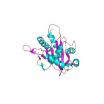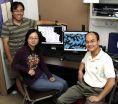(Press-News.org) Scientists at the Institute for Research in Biomedicine (IRB Barcelona) headed by the coordinator of the Structural and Computational Biology Programme, Miquel Coll, have published a new study that demonstrates that raltegravir, the drug approved in 2007 for the treatment of AIDS that is sold by Merck under the name Isentress, cancels the function of an essential protein for the replication of one kind of herpes virus. This study, published in the journal Proceedings of the National Academy of Sciences (PNAS), is the first step towards the development of a drug against the entire herpesvirus family.
"These results have a clear medical impact for three reasons", explains Miquel Coll, also a CSIC research professor. "First, humans do not have the viral protein that is affected, thus this would allow a highly specific drug that does not show the secondary effects that other drugs may have. Second, the inhibitor is not toxic for humans when administered at therapeutic concentrations because it is already on the market and thus toxicity tests are facilitated; and third, we have data that indicate that all herpes viruses have this protein. Therefore, it could be a valid target against all Herpesviridae."
Herpesviruses include pathogens such as herpes simplex 1 and 2, the virus that causes chickenpox otherwise known as zoster virus, the Epstein-Barr virus –associated with several types of cancer -, the roseola virus, the cytomegalovirus and the herpes virus associated with Kaposi sarcoma –in AIDS patients -. The human cytomegalovirus (HCMV), on which the study was performed, causes neurological defects in 1% of neonates in developed countries. It also produces retinitis that deteriorates into blindness in 25% of subjects with AIDS, defects in the brains and central nervous systems of young adults, inflammation of the colon –also in those with AIDS -, mononucleosis and serious diseases of the throat. Although 90% of adults carry HCMV, this virus is opportunistic, acting in people with weakened immune systems such as in cancer and AIDS patients, recipients of organ transplants and neonates.
Blocking viral replication
To replicate, the herpes virus enters the nucleus of a cell where it uses the cell machinery to copy its DNA several times into a single large chain. Once this copy has been made, acts a complex called terminase, formed by three protein subunits. The terminase cuts the new DNA into small fragments, the size of a single viral genome, and introduces these into empty shells (capsids) that have developed in the cell nucleus. Then, the new viruses leave the cell to continue infection. The researchers resolved the 3D structure of one part of the terminase and when they observed that it resembled the integrase of the AIDS virus, for which drugs are available, they tested it against the herpes virus protein. Thus they discovered that raltegravir acts on the subunit UL89 of the terminase and cancels the scissor function, which is required for viral replication.
The assays were performed directly on the protein in test tubes. "Now we must do the assays on whole infected cells, improve the effect of the drug and validate that it is also effective for other kinds of herpes viruses", explains Miquel Coll, whose lab has patented this second application for raltegravir. To resolve the 3D structure of the target protein, the scientists have used a state-of-the-art high-performance protein expression technique, with the collaboration with Darren Hart's group at EMBL in Grenoble, where 18,000 clones or different fragments of the protein have been tested. They have also used the Grenoble synchrotron to obtain the structural data. The study has lasted five years and forms part of the European project SPINE-2 complexes.
INFORMATION:
A drug against AIDS could be effective against the herpes virus
Researchers at IRB Barcelona have discovered this with the human cytomegalovirus, the most deadly and widespread herpes virus and the cause of serious defects in neonates
2010-09-24
ELSE PRESS RELEASES FROM THIS DATE:
Study reveals stress hormone impacts on alcohol recovery
2010-09-24
Scientists at the University of Liverpool have found that high levels of a stress hormone in recovering alcoholics could increase the risk of relapse.
The study showed that cortisol, a hormone produced by the adrenal gland in response to stress, is found in high levels in chronic alcoholics, as well as those recovering from the condition. Researchers found that this could result in impaired memory, attention and decision-making functions, which could decrease the patient's ability to engage with treatment.
Chronic alcoholism is a disabling addictive disorder, characterised ...
Psychotropic medication and youth in foster care report
2010-09-24
Boston, MA -
The Tufts Clinical and Translational Science Institute (CTSI) today issued a landmark report from a multi-state study on psychotropic medication oversight in foster care. Led by Laurel K. Leslie, MD, MPH at Tufts CTSI, Christopher Bellonci, MD at Tufts Medical Center and Justeen Hyde, PhD at Cambridge Health Alliance, the study examined state policies and practices in 47 states, including Massachusetts, and the District of Columbia regarding the use of medication for treating behavioral and mental health problems in foster care children and adolescents ages ...
Anger amplifies clinical pain in women with and without fibromyalgia
2010-09-24
Researchers from Utrecht University who studied the effect of negative emotions on pain perception in women with and without fibromyalgia found that anger and sadness amplified pain equally in both groups. Full findings are now online and will publish in the October print issue of Arthritis Care & Research, a journal of the American College of Rheumatology.
Fibromyalgia (FM), a chronic pain condition, has among the largest impact of all rheumatic and chronic pain conditions. In addition to chronic, widespread pain, patients report accompanying symptoms such as fatigue, ...
City living helped humans evolve immunity to TB
2010-09-24
New research has found that a genetic variant which reduces the chance of contracting diseases such as tuberculosis and leprosy is more prevalent in populations with long histories of urban living.
The research, published in the journal Evolution, shows that in areas with a long history of urban settlements, today's inhabitants are more likely to possess the genetic variant which provides resistance to infection.
In ancient cities, poor sanitation and high population densities would have provided an ideal breeding ground for the spread of disease. Natural selection ...
New map offers a global view of health-sapping air pollution
2010-09-24
In many developing countries, the absence of surface-based air pollution sensors makes it difficult, and in some cases impossible, to get even a rough estimate of the abundance of a subcategory of airborne particles that epidemiologists suspect contributes to millions of premature deaths each year. The problematic particles, called fine particulate matter (PM2.5), are 2.5 micrometers or less in diameter, about a tenth the fraction of human hair. These small particles can get past the body's normal defenses and penetrate deep into the lungs.
To fill in these gaps in surface-based ...
Wheat researchers combine forces to battle major disease
2010-09-24
AMARILLO - Wheat streak mosaic virus is the most prevalent disease in the southwestern wheat producing region of the U.S., according to a Texas AgriLife Research scientist.
Dr. Charlie Rush, AgriLife Research plant pathologist in Amarillo, is assembling several teams of scientists to work on the disease from every aspect: vector to diagnosis and mapping to control.
"There are other diseases of concern, but wheat streak mosaic is always found somewhere in this wheat growing region, and every couple of years, we have an epidemic of it," Rush said.
Several issues cause ...
Genetic switch underlies noisy cell division
2010-09-24
DURHAM, N.C. – While scientists have spent the past 40 years describing the intricate series of events that occur when one mammalian cell divides into two, they still haven't agreed on how the process begins.
There are two seemingly contradictory theories, which now may be reconciled by a third theory being proposed by Duke University bioengineer Lingchong You. These findings could provide insights into the initiation of disease, such as cancer, which is marked by uncontrolled cell proliferation.
During proliferation, the DNA within the nucleus of a cell makes a copy ...
Iowa State, Ames Lab researchers identify structure that allows bacteria to resist drugs
2010-09-24
AMES, Iowa – A research team led by Edward Yu of Iowa State University and the Ames Laboratory has discovered the crystal structures of pumps that remove heavy metal toxins from bacteria, making them resistant to antibiotics.
The findings are published in the Sept. 23 issue of the journal Nature.
Yu – an Iowa State associate professor of chemistry, of physics and astronomy, of biochemistry, biophysics and molecular biology and an associate of the U.S. Department of Energy's Ames Laboratory – said the finding gives researchers a better understanding of bacterial resistance ...
K-State research explains brand reputation's key role in a store-within-a-store
2010-09-24
MANHATTAN, KAN. -- With the concept of a store-within-a-store growing across the country, a Kansas State University researcher's work shows the increasing importance of brand reputation and its strong role in governing decisions.
Richard McFarland, associate professor of marketing, and four colleagues recently completed "Understanding Governance Decisions in a Partially Integrated Channel: A Contingent Alignment Framework." Their research will be published in the elite Journal of Marketing Research next year.
The research looks at separate companies who entered a store-within-a-store ...
Why are there no hyenas in Europe?
2010-09-24
A team from the National Museum of Natural Sciences (CSIC) has analysed the impact of climate change on spotted hyena survival in Europe over 10,000 years ago. These changes played an important role, but the scientists say studies are still needed to look at the influence of human expansion and changes in herbivorous fauna on the definitive extinction of this species across the continent.
"Climate change in the past was not directly responsible for the extinction of the spotted hyena in southern Europe, but it was a factor in its disappearance", Sara Varela, lead author ...
LAST 30 PRESS RELEASES:
Breakthrough organic crystalline material repairs itself in extreme cold temperatures, unlocking new possibilities for space and deep-sea technologies
Scientists discover novel immune ‘traffic controller’ hijacked by virus
When tropical oceans were oxygen oases
Positive interactions dominate among marine microbes, six-year study reveals
Safeguarding the Winter Olympics-Paralympics against climate change
Most would recommend RSV immunizations for older and pregnant people
Donated blood has a shelf life. A new test tracks how it's aging
Stroke during pregnancy, postpartum associated with more illness, job status later
American Meteorological Society announces new executive director
People with “binge-watching addiction” are more likely to be lonely
Wild potato follows a path to domestication in the American Southwest
General climate advocacy ad campaign received more public engagement compared to more-tailored ad campaign promoting sustainable fashion
Medical LLMs may show real-world potential in identifying individuals with major depressive disorder using WhatsApp voice note recordings
Early translational study supports the role of high-dose inhaled nitric oxide as a potential antimicrobial therapy
AI can predict preemies’ path, Stanford Medicine-led study shows
A wild potato that changed the story of agriculture in the American Southwest
Cancer’s super-enhancers may set the map for DNA breaks and repair: A key clue to why tumors become aggressive and genetically unstable
Prehistoric tool made from elephant bone is the oldest discovered in Europe
Mineralized dental plaque from the Iron Age provides insight into the diet of the Scythians
Salty facts: takeaways have more salt than labels claim
When scientists build nanoscale architecture to solve textile and pharmaceutical industry challenges
Massive cloud with metallic winds discovered orbiting mystery object
Old diseases return as settlement pushes into the Amazon rainforest
Takeaways are used to reward and console – study
Velocity gradients key to explaining large-scale magnetic field structure
Bird retinas function without oxygen – solving a centuries-old biological mystery
Pregnancy- and abortion-related mortality in the US, 2018-2021
Global burden of violence against transgender and gender-diverse adults
Generative AI use and depressive symptoms among US adults
Antibiotic therapy for uncomplicated acute appendicitis
[Press-News.org] A drug against AIDS could be effective against the herpes virusResearchers at IRB Barcelona have discovered this with the human cytomegalovirus, the most deadly and widespread herpes virus and the cause of serious defects in neonates


